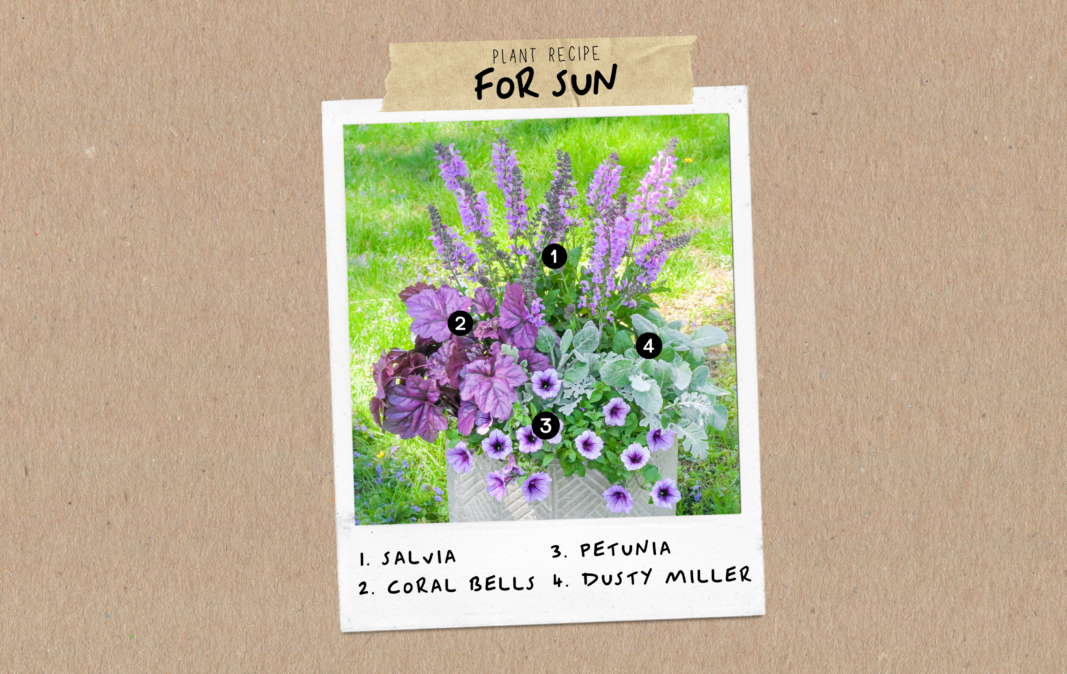 Bryn Wallace
Bryn WallacePurple Cottage Container for Sun
This container has purple-hued flowers accompanied by the silvery foliage of dusty Miller. These plants are easily interchangeable with other colors of orange, pink, red and white if you’re looking for more contrast. The tall salvia adds height while the petunias cascade down the front of the pot and the heuchera fills out the mid-ground with its full, bushy texture. The container as a whole resembles a cottage design that can be used to liven up any sunny area of the garden that receives 6 to 8 hours of sunlight daily.
Plants Featured
Salvia
This perennial plant produces tubular, tall blooms, in shades of blue, pink, purple, red and white. If you deadhead the salvia by removing the blooms when they are finished, your plant will rebloom from spring through fall. Salvias are typically deer resistant and are beloved by bees, butterflies and hummingbirds. They are heat and drought tolerant, making them ideal for full sun exposure. If you wish to take your salvia out of the container and plant it in the garden, find a space where it can get at least 6 to 8 hours of sunlight daily.
Heuchera
This evergreen perennial has beautiful burgundy/purple foliage. There are other varieties with blush, chartreuse orange, and multi-colored foliage. In the spring it produces long stems with delicate white and pink flowers that dance above the foliage. After the heuchera blooms, remove the spent blossoms using clippers. This will allow the plant to focus its energy on producing additional leaves and let the beautiful foliage take center stage.
Petunia
These annuals come in all kinds of colors, including blue, orange, pink, purple, red, white and yellow. They have a long bloom period from springtime until the first frost. Along with containers, petunias look great in hanging baskets or as a vibrant groundcover. We suggest removing old or dead blossoms and pruning the shoots back to half their length to encourage the plant to produce new flowers when they get leggy in midsummer.
Dusty Miller
This velvety plant with gray to silver foliage is heat and drought tolerant, making it ideal for sunny areas in your yard. While the plant is typically considered an annual in this area, it often behaves as a perennial and will frequently live over winter. In the garden, dusty Miller’s attractive gray coloring provides a cool backdrop for warm toned plants to pop off. Remove the dead foliage as it appears throughout the season to keep the plant looking happy and healthy.
Planting Instructions
If you’re looking to replicate this container in your own home, follow our step by step potting instructions. Here is an abbreviated version.
1. Select a container. Choose a container with drainage holes. This allows excess water to drain out of the bottom of the pot, letting the roots take in the oxygen they need to survive. When choosing a container, consider the size of the plants you’re planning to put into it. You want to allow plenty of room for root growth. The larger the pot, the more soil you can use, meaning there is more room for growth and it is easier to keep that soil moist.
2. Add Merrifield Potting Mix. We recommend using a well draining potting soil to allow adequate moisture and oxygen balance for optimal plant health. Before you pour in your soil, place a piece of landscape fabric or a coffee filter over the drainage holes in your container. This will prevent soil from leaking out of the holes. Add Merrifield Potting Mix until the container is around ⅔ full.
3. Add a slow release fertilizer. Mix a slow release plant food, such as organic Plant Tone, into the soil. This will provide a continual release of nutrients for your plants to thrive. Follow the instructions on the bag for the amount of fertilizer to add based on the size of your container. Follow up with a liquid fertilizer every 3 to 4 weeks.
4. Add your plants. Before placing your plants into the soil, we suggest arranging your plants in their growers pots to see what the layout will look like when they are planted. Then, working with the tallest plant first, salvia in this instance, remove the growers pot and loosen the roots, tucking the plant into your fertilized soil. Continue planting with the heuchera, petunias and dusty miller in the same way. As you’re planting, you can tuck in more potting soil as you need it. The goal is to keep the soil around 1” below the lip of the container when you are finished planting.
5. Top dress your container. Use decorative rocks or mulch in a thin layer over the surface of your soil to help retain moisture, keep critters out of the soil, and keep the soil in the pot when watering.
6. Water thoroughly. After everything is planted, water until the soil is thoroughly moistened. If you’re placing the container on a wood surface like a deck or a balcony, we suggest using a saucer or plant toes or plant feet to keep the container lifted off of the ground so that excess water does collect under your pot and potentially damage your surface.
7. Fertilize throughout the growing season. We recommend reapplying Plant Tone two or three times during the growing season, pouring it directly on top of the soil. If you’re using a decorative soil cover, push it aside to place the Plant Tone directly on the soil surface. Follow the instructions on the bag for the amount to apply for continual feeding.
Ongoing Care
Watering
The plants in this container will thrive with moist soil. You do not want the soil to completely dry out or remain soaking wet. In general, you will likely need to check the soil for water every 1 to 2 days. Use your finger to reach into the soil a few inches deep and feel if the soil is wet or dry. If the soil is beginning to dry out, water thoroughly until the soil is totally saturated and feels like a soaking wet sponge and water runs through the drainage holes of the container.
Overwintering
Both the salvia and heuchera are perennial, so they will live throughout the winter season. Dusty Miller, although typically considered to be an annual, will frequently behave as a perennial as well, surviving over the winter. If you’re planting in a high quality planter, such as wood, well-fired ceramics or frost resistant terracotta, your plants will likely overwinter just fine, provided the pot is elevated off the ground using plant toes or plant feet to prevent water from collecting and cracking the pot. If we’re expecting severe winter weather in our area, we recommend wrapping the container in bubble wrap and burlap or insulating a group of containers in mulch to provide extra root protection.



